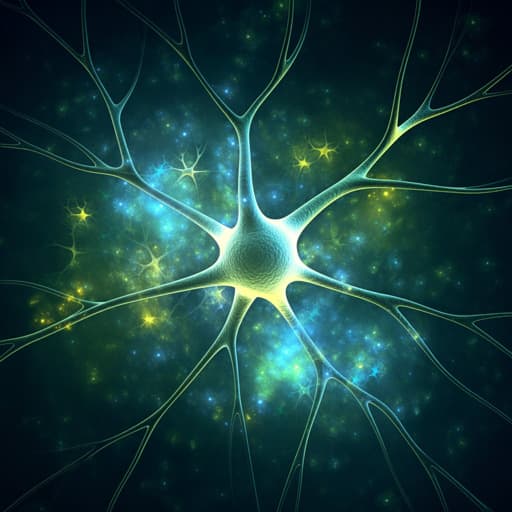
Psychology
Psilocybin for treatment-resistant depression without psychedelic effects: study protocol for a 4-week, double-blind, proof-of-concept randomised controlled trial
M. I. Husain, D. M. Blumberger, et al.
Explore a groundbreaking study conducted by Muhammad Ishrat Husain and colleagues, investigating the effects of psilocybin combined with risperidone in adults with treatment-resistant depression. This trial addresses the feasibility and potential antidepressant effects while unraveling psilocybin's mechanisms of action.
~3 min • Beginner • English
Introduction
Treatment-resistant depression (TRD), affecting up to one-third of individuals with major depressive disorder (MDD), is associated with significant functional impairment, elevated suicidality, and increased mortality. Existing treatments for TRD have modest response rates and problematic adverse effects, and while electroconvulsive therapy is efficacious, its uptake is limited by access, stigma, and cognitive side-effect concerns. Recent studies suggest psilocybin-assisted psychotherapy (PAP) produces large and sustained antidepressant effects in MDD and TRD, but all trials have involved psychedelic experiences and intensive therapist support, limiting scalability and leaving unclear whether the psychedelic effects are necessary for therapeutic benefit. The central research question is whether psilocybin’s antidepressant effects depend on 5-HT2A receptor-mediated psychedelic experiences. This protocol tests whether pre-treatment with risperidone, a 5-HT2A antagonist, can block psychedelic effects while preserving antidepressant efficacy, thereby potentially increasing acceptability and scalability of psilocybin treatment for TRD.
Literature Review
Multiple open-label and randomized controlled trials indicate that psilocybin, alongside psychological support, yields large short- and longer-term reductions in depressive symptoms in MDD and TRD, with notable effect sizes and remission rates reported up to 12 months. A head-to-head trial found two doses of psilocybin-assisted therapy comparable to 6 weeks of escitalopram. A larger phase 2 RCT in TRD showed that 25 mg psilocybin significantly reduced MADRS scores versus 1 mg active placebo for at least 6 weeks without increased serious adverse events. However, limitations include small samples, inadequate control groups, unblinding due to conspicuous psychedelic effects, and highly selected participants. The prevailing assumption is that antidepressant effects require 5-HT2A receptor activation and associated altered states, although evidence is indirect. Human studies show that ketanserin or risperidone can block the subjective psychedelic effects of psilocybin. Preclinical work in a chronic stress mouse model suggests psilocybin’s anti-anhedonic effects may be independent of 5-HT2A activation, as ketanserin pre-treatment did not prevent benefit. One clinical study found no significant association between psychedelic intensity and sustained antidepressant response. Together, these findings motivate a human trial to test whether blocking psychedelic effects compromises antidepressant efficacy.
Methodology
Design: Single-site, phase 2, 4-week, double-blind, placebo-controlled, three-arm parallel-group randomized controlled trial conducted at the Centre for Addiction and Mental Health (CAMH), Toronto, Canada. Allocation is 1:1:1 with a double-dummy approach. No placebo-plus-placebo arm to enhance allocation concealment using active placebos and to improve efficiency in a TRD sample.
Participants: N=60 out-patients aged 18–65 years with DSM-5 MDD (non-psychotic) and current major depressive episode meeting TRD criteria: HRSD-17 >14 and non-response to ≥2 adequate antidepressant trials (per ATHF). Capacity for consent, English literacy, ability to take oral medication, normal labs (eGFR >40 mL/min/1.73 m2). Required washout off antidepressants/antipsychotics and specified metabolic enzyme inhibitors for ≥2 weeks before baseline and throughout the trial, confirmed safe by treating physicians. Exclusions include pregnancy/breastfeeding, recent investigational treatments, recent initiation of psychotherapy, substance use disorder within 6 months (except permitted substances), active suicidal ideation with intent/plan, lifetime psychotic or bipolar disorders, OCD, neurocognitive disorder, certain personality disorders, first-degree family history of psychotic or bipolar disorders, cardiovascular and other medical contraindications to psilocybin, prolonged QTc or long QT history, lifetime serotonergic psychedelic use, risperidone allergy/contraindication, or other significant illnesses increasing risk or confounding results.
Recruitment and consent: Out-patient referrals within Greater Toronto Area; pre-screen by phone; written informed consent obtained by trained staff; participants remain under care of a CAMH study psychiatrist; usual care providers informed.
Baseline and preparation (Visit 2): After medication taper, baseline clinical assessments and questionnaires, and a 2-hour preparatory psychotherapy session using the Yale Manual for Psilocybin-Assisted Therapy of Depression (ACT framework). Randomisation stratified by baseline HRSD severity (≤25 vs ≥26), using computer-generated permuted blocks with variable sizes; allocation concealed by the research pharmacist.
Interventions and dosing (Visit 3, Day 0): Three groups receive: (1) risperidone 1 mg followed 60 min later by psilocybin 25 mg; (2) placebo risperidone followed 60 min later by psilocybin 25 mg; (3) risperidone 1 mg followed 60 min later by placebo psilocybin. All capsules administered under clinician supervision with water; no chewing/opening. After the second capsule, participants rest with inward focus aided by a quiet music playlist. Approximately 5–6 hours post-second capsule, participants discuss experiences with therapists; discharge about 8 hours post-dose when acute effects have resolved in physician’s judgment.
Psychotherapy: Approximately 12 hours total manualised therapy delivered by licensed or supervised therapists trained in the Yale manual and study protocol, with ongoing peer supervision. One preparatory session within 7 days pre-dose (ideally the day before), optional additional preparation, and two integration sessions at 1 day (Visit 4) and 1 week (Visit 5) post-dose. Therapy uses an ACT-informed PAP approach emphasizing psychological flexibility; sessions are delivered by a therapist dyad consistent across visits.
Blinding: Double-blind for investigators, therapists, raters, participants; the pharmacist is unblinded but separate. Active placebo effects of risperidone (e.g., drowsiness/dysphoria) expected to enhance blinding. Blinding integrity assessed at Week 2 with a conventional guess form for participants and raters. Emergency unblinding only if clinically required; any unblinding reported to REB and Health Canada.
Follow-up and assessments: Follow-up at Weeks 2, 3, and 4 post-dose (Visits 6–8), remote or in-person, assessing depression, anxiety, quality of life, and well-being.
Outcomes:
- Primary (feasibility, tolerability, safety): Recruitment and completion rates overall and by group; drop-outs attributed to adverse events; serious adverse events rates by group.
- Secondary (psychedelic effects): 5-Dimensional Altered States of Consciousness Rating Scale (5D-ASC) total score at end of dosing day (Visit 3), completed after acute effects have worn off.
- Exploratory (antidepressant efficacy): MADRS at baseline and Visits 4–8 to assess changes across groups. Additional measures include CGI, GAD-7, Snaith-Hamilton Anhedonia Scale, WHOQOL-BREF, and WEMWBS. Expectancy measured by the Stanford Expectations of Treatment Scale at baseline.
Sample size and power: N=60 (n=20 per arm) consistent with pilot trial recommendations, providing informative confidence intervals. Power 0.80 to detect d≈0.96 on 5D-ASC when comparing psilocybin+placebo vs psilocybin+risperidone or placebo+risperidone; exploratory power 0.80 to detect effect sizes ~0.91–0.96 on MADRS changes over 2 days and 4 weeks between psilocybin groups and risperidone+placebo, assuming 10% drop-out, two-tailed α=0.05.
Statistical analysis: Intention-to-treat with blinded group labels; full information maximum likelihood for missing data; diagnostic and sensitivity analyses for outliers/influence, normality, and MAR assumptions. Feasibility/tolerability/safety via frequency analyses. Clinical outcomes analyzed using generalized linear models; mixed-effects models with individual random effects for longitudinal data. Primary predictor is treatment assignment; covariates include age, self-reported gender at birth, and baseline MADRS. Non-inferiority test (exploratory, not powered) to assess comparability of psilocybin+risperidone to psilocybin+placebo on MADRS; paired permutation t-tests to assess 50% MADRS reduction with psilocybin+risperidone. Dichotomous outcomes compared with chi-squared tests or GEE for repeated measures. Report point estimates and confidence intervals; exploratory results uncorrected. No interim analyses.
Safety monitoring: Pre-randomization labs (blood, urine), ECGs; C-SSRS used at entry and each visit with a Suicide Risk Management Protocol for positive ideation. Adverse events collected from consent through Visit 8. Independent Data Safety Monitoring Board (trialist chair, biostatistician, clinician) with charter, meets at least annually and can access unmasked data if needed; recommendations to PI and Trial Steering Committee.
Governance and ethics: Trial Steering Committee (independent of funders and psilocybin supplier) oversees conduct, meets quarterly, includes patient representative and external experts. Data protected per CAMH policies; coded, encrypted, password-protected databases, secure storage of paper records; confidentiality per REB. Registered at ClinicalTrials.gov (NCT05710237). Approved by CAMH REB (#080-2022; protocol v2.0; 22 Feb 2023). Conduct adheres to Good Clinical Practice and the Declaration of Helsinki.
Timeline: Recruitment anticipated to start May 2023; 36-month total duration. Startup 6 months; recruit 2–3/month over 24 months; interventions and follow-up by month 28; data analysis and reporting by month 36. Minimum of 12 visits over 8–10 weeks per participant (including washout check-ins); screening/washout 4–6 weeks; randomized period 4 weeks.
Key Findings
This is a study protocol; no clinical outcomes are reported. The trial’s primary endpoints are feasibility, tolerability, and safety; secondary assesses psychedelic effects (5D-ASC), with exploratory antidepressant effects (MADRS).
Discussion
This trial addresses whether psilocybin’s antidepressant efficacy in TRD requires 5-HT2A-mediated psychedelic experiences. By pharmacologically blocking 5-HT2A receptors with risperidone, the study tests if therapeutic benefits can be achieved without altered states, potentially improving acceptability for patients apprehensive about psychedelic experiences and overcoming scalability barriers associated with intensive psychotherapy and monitoring. If psilocybin combined with risperidone demonstrates antidepressant effects comparable to psilocybin alone, the findings would challenge the assumption that psychedelic experiences are necessary and suggest alternate mechanisms (e.g., other serotonergic receptor interactions, neuroplasticity, BDNF modulation, anti-inflammatory effects, or synaptic connectivity changes). Clinically, demonstrating feasibility and safety of a non-psychedelic regimen could broaden access and streamline delivery. Regardless of outcome, the trial will inform mechanistic understanding and guide the design of larger efficacy trials and optimization of therapeutic components (e.g., psychotherapy dosing).
Conclusion
This protocol outlines a double-blind, three-arm RCT to evaluate the feasibility, tolerability, and safety of combining psilocybin with risperidone in adults with TRD, to test whether blocking psychedelic effects diminishes antidepressant benefits. The study will clarify psilocybin’s mechanism of action and inform the scalability of psilocybin treatments by potentially decoupling therapeutic effects from psychedelic experiences. Results will guide the design of larger definitive trials and may facilitate broader clinical adoption of psilocybin-based interventions if a non-psychedelic approach proves safe and potentially effective.
Limitations
As a single-site, small pilot (n=60), the study is not powered for definitive efficacy conclusions and has limited generalizability. The short 4-week follow-up precludes assessment of durability and longer-term safety. Inclusion criteria (e.g., medication washout, exclusion of certain comorbidities and prior psychedelic exposure) may limit external validity. Absence of a placebo-plus-placebo arm may constrain interpretation of nonspecific effects. Despite blinding efforts, psychoactive effects could still influence blinding integrity. The protocol includes 12 hours of psychotherapy, which may confound assessments of psilocybin’s standalone effects and does not directly address scalability of minimal-support models.
Related Publications
Explore these studies to deepen your understanding of the subject.







